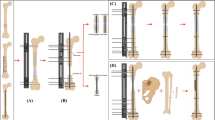Abstract
Purpose
Treatment of the sequellae of hip infection with epiphyseal destruction in children has had limited success to date. The aim of this study was to report mid-term results after hip epiphyseal reconstruction using a proximal vascularized fibular graft in three children presenting with massive epiphyseal destruction of the proximal femur following infection.
Methods
Three children suffered from hip articular destruction type IVB according to the Choi classification after neonatal septic arthritis. The mean age at reconstruction was 4.3 years (range 3–6 years). The Hunka et al. criteria were used to evaluate the functional results, and the clinical evaluation was based on the Musculo-Skeletal Tumor Society (MSTS) score. Growth and fusion of the graft and hip morphology were evaluated on simple X-rays and by magnetic resonance imaging (MRI). A ratio between cephalic diameter and inter-acetabular gap was defined on the MRI scan as the “acetabular filling index”.
Results
No intraoperative complication was reported. With a mean follow-up of 4.8 years (3–6 years), the MSTS score was 22.7/30 (range 20–26), while the average lower limb length discrepancy was 3 cm. Patient 1 required a secondary derotation osteotomy of the femur because of abnormal external rotation and a bad result due to the unexplained occurrence of a painful and stiff hip joint. A secondary distal transfer of the greater trochanter was performed in patient 2, and good results based on Hunka et al.’s criteria were achieved. The X-rays of patients 1 and 2 showed signs of bone growth and a major remodeling process; the MRI filling indices were 83 and 67%, respectively. Patient 3 developed an early slipped capital (fibular) epiphysis 1 month postoperatively, which was treated by percutaneous pinning; this early complication led to a bad result with full resorption of the graft.
Conclusions
In contrast to its success in upper limb reconstruction, in this series of three patients with hip articular destruction, articular reconstruction using a vascularized proximal fibula graft was disappointing and led to unsatisfactory results in terms of hip reconstruction. Such a procedure is complex and highly demanding, necessitating extremely intensive post-operative care. An early slipped capital epiphysis can lead to full graft resorption. Consequently, despite important adaptation and remodeling of the graft, the authors do not recommend this procedure at this location.



Similar content being viewed by others
References
Mitchell GP (1980) Management of acquired dislocation of the hip in septic arthritis. Orthop Clin North Am 11:51–64
Wopperer JM, White JJ, Gillespie R et al (1988) Long-term follow-up of infantile hip sepsis. J Pediatr Orthop 8:322–325
Lloyd-Roberts GC (1979) Septic arthritis in infancy. Aust Paediatr J 15:41–43
Fabry G, Meire E (1983) Septic arthritis of the hip in children: poor results after late and inadequate treatment. J Pediatr Orthop 3:461–466
Choi IH, Pizzutillo PD, Bowen JR et al (1990) Sequelea and reconstruction after septic arthritis of the hip in infants. J Bone Joint Surg Am 72(8):1150–1165
Cheng JC, Aguilar J, Leung PC (1995) Hip reconstruction for femoral head loss from septic arthritis in children. A preliminary report. Clin Orthop Relat Res 314:214–224
Axer A, Aner A (1984) A new technique for greater trochanteric hip arthroplasty. J Bone Joint Surg Br 66(3):331–333
Wada A, Fujii T, Takamura K et al (2007) Operative reconstruction of the severe sequelae of infantile septic arthritis of the hip. J Pediatr Orthop 27(8):910–914
Innocenti M, Delcroix L, Romano GF et al (2007) Vascularized epiphyseal transplant. Orthop Clin North Am 38:95–101. doi:10.1016/j.ocl.2006.10.003
Manfrini M, Innocenti M, Ceruso M et al (2003) Original biological reconstruction of the hip in a 4-year-old girl. Lancet 361:140–142. doi:10.1016/S0140-6736(03)12192-7
Forlin E, Milani C (2008) Sequelae of septic arthritis of the hip in children. A new classification and a review of 41 hips. J Pediatr Orthop 28:524–528
Betz RR, Cooperman DR, Wopperer JM et al (1990) Late sequelae of septic arthritis of the hip in infancy and childhood. J Pediatr Orthop 10:365–372
Hunka L, Said SE, Mackenzie DA et al (1982) Classification and surgical management of the severe sequelea of septic hips in children. Clin Orthop Relat Res 171:30–36
Enneking W, Dunham W, Gebhardt M et al (1993) A system for the functional evaluation of reconstructive procedures after surgical treatment of tumors of the musculoskeletal system. Clin Orthop Relat Res 286:241–246
De Boer HH, Wood MB (1989) Bone changes in the vascularised fibular graft. J Bone Joint Surg Br 71:374–378
Manzotti A, Rovetta L, Pullen C et al (2003) Treatment of the late septic arthritis of the hip. Clin Orthop Relat Res 410:203–212. doi:10.1097/01.blo.0000063782.32430.37
Rozbruch SR, Paley D, Bhave A et al (2005) Ilizarov hip reconstruction for the late sequelae of infantile hip infection. J Bone Joint Surg Am 87(5):1007–1018. doi:10.2106/JBJS.C.00713
Dobbs MB, Sheridan JJ, Gordon JE et al (2003) Septic arthritis of the hip in infancy: long-term follow-up. J Pediatr Orthop 23(2):162–168. doi:10.1097/00004694-200303000-00006
Wang EB, Ji SJ, Zhao Q, Zhang LJ (2007) Treatment of severe sequelae of infantile hip sepsis with trochanteric arthroplasty. J Pediatr Orthop 27(2):165–170
Hallel T, Salvati EA (1978) Septic arthritis of the hip in infancy: end result study. Clin Orthop Relat Res 132:115–128
Innocenti M, Delcroix L, Manfrini M et al (2005) Vascularized proximal fibular epiphyseal transfer for distal radial reconstruction. J Bone Joint Surg Am 87[Suppl 1]:237–246
Author information
Authors and Affiliations
Corresponding author
About this article
Cite this article
Debarge, R., Chotel, F., Gazarian, A. et al. Failed vascularized proximal fibular epiphyseal transfer for hip reconstruction following infection in children. J Child Orthop 3, 325–330 (2009). https://doi.org/10.1007/s11832-009-0181-x
Received:
Accepted:
Published:
Issue Date:
DOI: https://doi.org/10.1007/s11832-009-0181-x




